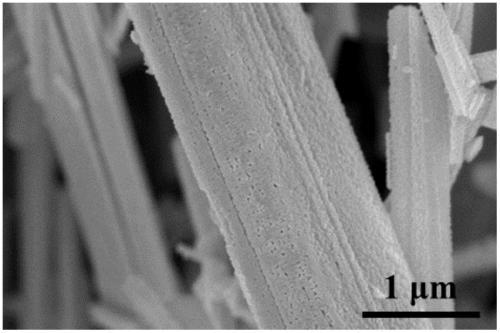Lithium titanate of porous structure as well as preparation method and application thereof
A technology of structural lithium titanate and porous structure, applied in the directions of titanate, structural parts, alkali metal titanate, etc., can solve the problem of few synthetic reports, and achieve easy control of process parameters, effective migration, and easy large-scale The effect of industrial production
- Summary
- Abstract
- Description
- Claims
- Application Information
AI Technical Summary
Problems solved by technology
Method used
Image
Examples
Embodiment 1
[0072] according to figure 1 Process, first, hydrogen peroxide and lithium hydroxide are dissolved in water to form an aqueous solution with a concentration of lithium hydroxide of 0.6 moles per liter and a volume fraction of hydrogen peroxide of 2%. Under the condition of stirring, slowly add 2 grams of tetrabutyl titanate into the above 100 ml aqueous solution, and stir to form a yellow transparent solution. Subsequently, the above-mentioned yellow transparent solution was heated to 70 degrees Celsius and stirred at constant temperature for 6 hours to stop the reaction to obtain a white solid. Subsequently, the above-mentioned white solid was separated by centrifugation, and the moisture content of the separated solid was about 58%, and then put into an oven, and dried under vacuum at 60 degrees Celsius. Subsequently, the above dried sample was placed in an oven at 200 degrees Celsius for 20 hours at a constant temperature to completely remove the hydrogen peroxide adsorbed...
Embodiment 2
[0074] First, hydrogen peroxide and lithium hydroxide are dissolved in water to form an aqueous solution with a concentration of lithium hydroxide of 0.45 moles per liter and a volume fraction of hydrogen peroxide of 1%. Under the condition of stirring, slowly add 0.2 g of titanium sulfate to the above 100 ml aqueous solution, and stir to form a yellow transparent solution. Subsequently, the above-mentioned yellow transparent solution was heated to 60 degrees Celsius and stirred at constant temperature for 24 hours to stop the reaction to obtain a white solid. Subsequently, the above-mentioned white solid was separated by filtration, and the moisture content of the separated solid was about 55%, and then put into an oven, and dried under vacuum at 50 degrees Celsius. Subsequently, the above-mentioned dried white solid was placed in an oven at 150 degrees centigrade for constant temperature annealing treatment for 24 hours to completely remove the hydrogen peroxide adsorbed and...
Embodiment 3
[0076] First, hydrogen peroxide and lithium hydroxide are dissolved in water to form an aqueous solution with a concentration of lithium hydroxide of 0.8 moles per liter and a volume fraction of hydrogen peroxide of 5%. Under the condition of stirring, slowly add 5 grams of titanium isopropoxide into the above 100 ml aqueous solution, and stir to form a yellow transparent solution. Subsequently, the above-mentioned yellow transparent solution was heated to 98 degrees Celsius and stirred at constant temperature for 2 hours to stop the reaction to obtain a white solid. Subsequently, the above-mentioned white solid was separated by means of suction filtration, and the moisture content of the separated solid was about 50%, and then put into an oven, and dried under vacuum at 70 degrees Celsius. Subsequently, the above-mentioned dried white solid was placed in an oven at 250 degrees centigrade for constant temperature annealing treatment for 2 hours to completely remove the hydroge...
PUM
 Login to View More
Login to View More Abstract
Description
Claims
Application Information
 Login to View More
Login to View More - R&D
- Intellectual Property
- Life Sciences
- Materials
- Tech Scout
- Unparalleled Data Quality
- Higher Quality Content
- 60% Fewer Hallucinations
Browse by: Latest US Patents, China's latest patents, Technical Efficacy Thesaurus, Application Domain, Technology Topic, Popular Technical Reports.
© 2025 PatSnap. All rights reserved.Legal|Privacy policy|Modern Slavery Act Transparency Statement|Sitemap|About US| Contact US: help@patsnap.com



